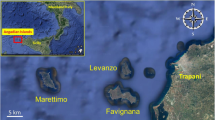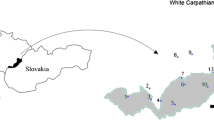Abstract
In 1969, Galt and Galt conducted an ethnobotanical survey in the community of Khamma on the volcanic island of Pantelleria, Italy. Since then, a number of botanical studies concerning the local wild flora and cultivation of the zibibbo grape and capers have been conducted, but none have investigated traditional ecological knowledge (TEK) regarding the use of wild plants and fungi. We documented the current TEK and practices concerning wild plants and fungi on the island, focusing on uses related to food and medicine with 42 in-depth interviews in six communities in June 2014. Our aim was to examine shifts in TEK, represented in terms of loss or gain of specific species uses, in comparison to the 1969 study. All interviews were conducted in person in Italian with prior informed consent. We employed two primary means of eliciting responses concerning traditional practices; informants were asked to: 1) free-list the most commonly used plants for wild foods, general medicine, and skin remedies; and 2) view and discuss a booklet composed of photos of species reported in the Galt and Galt study. In total, 86 botanical and 19 fungal species representing 53 families were cited. While many plant-based traditions have disappeared from daily practice, especially those related to traditional fishing and hunting, they remain in the memories of the eldest subset of the population. For example, one of the most pervasive species in the landscape, Opuntia ficus-indica, has current day uses that persist as a food source, but its past applications were much more diverse, and included manipulation into hunting snares for birds. Other predominant flora included a number of Euphorbia spp., whose toxic latex was regularly used as a fish poison. Fungi, on the other hand, nowadays represent an important source of wild food. In conclusion, we documented a decline in knowledge and practice of TEK related to ritual healing, livestock rearing, hunting and fishing practices and an increase in TEK concerning newly introduced edible fungi.
Abstract (Italiano)
Nel 1969, Galt e Galt hanno condotto un’indagine etnobotanica presso la comunità di Khamma dell’isola vulcanica di Pantelleria, in Italia. Da allora, sono stati condotti una serie di studi botanici riguardanti la flora spontanea locale e la coltivazione della vite zibibbo ed i capperi, ma nessuno ha eseguito indagini relative alle conoscenze ecologiche tradizionali (TEK) per quanto riguarda l’uso delle piante selvatiche e dei funghi. Abbiamo documentato le attuali TEK e le pratiche sugli usi delle piante spontanee e dei funghi dell’isola, focalizzando l’attenzione sugli usi come alimento ed in campo medico, grazie a 42 interviste approndite, condotte in sei comunità nel giugno del 2014. Il nostro scopo era di esaminare i cambiamenti nelle TEK, rappresentati in termini di perdita o acquisizione dell’uso specifico di alcune specie, in confronto con lo studio del 1969. In totale, 86 specie di piante e 19 specie fungine incluse in 53 famiglie sono state citate dagli intervistati. Nonostante molte tradizioni legate alle piante siano scomparse dalla pratica quotidiana, in particolare quelle legate alla pesca tradizionale e la caccia, esse rimangono nei ricordi degli individui più anziani della popolazione. Ad esempio, una delle specie più diffuse nel paesaggio, Opuntia ficus-indica, viene oggi utilizzata esclusivamente come fonte di cibo, ma le sue applicazioni in passato erano molto più diversificate, e comprendevano anche la costruzione di trappole per la cattura di piccoli uccelli. La flora comprende un rilevante numero di Euphorbia spp., il cui lattice tossico veniva utilizzato come veleno per i pesci. I funghi, oggi rappresentano esclusivamente una fonte di cibo naturale. In conclusione, abbiamo osservato un declino relativamente alla conoscenza e la pratica di TEK relative alla medicina rituale, all'allevamento, alla caccia ed alla pesca, ed un incremento delle TEK che riguarda l‘utilizzo di funghi eduli.




Similar content being viewed by others
Literature Cited
Barbera, G., F. Carimi, and P. Inglese. 1992. Past and present role of the Indian-fig prickly-pear (Opuntia ficus-indica (L.) Miller, Cactaceae) in the agriculture of Sicily. Economic Botany 46(1):10–20.
Berkes, F. 1993. Traditional ecological knowledge in perspective. Pages 1–9 in J. T. Englis, ed., Traditional ecological knowledge: Concepts and cases. International Program on Traditional Ecological Knowledge and International Development Research Centre, Ottawa, Ontario.
———, J. Colding, and C. Folke. 2000. Rediscovery of traditional ecological knowledge as adaptive management. Ecological Applications 10:1251–1262.
Botelho, G. F., F. Gomes, M. Ferreira, and I. Caldeira. 2015. Influence of maturation degree of Arbutus (Arbutus unedo L.) fruits in spirit composition and quality. International Journal of Biological, Food, Veterinary and Agricultural Engineering 9(6):478–483.
Calò C., P.D. Henne, P. Eugster, J. van Leeuwen, A. Gilli, Y. Hamann, T. La Mantia, S. Pasta, E. Vescovi and W. Tinner. 2013. 1200 years of decadal-scale variability of Mediterranean vegetation and climate at Pantelleria Island, Italy. The Holocene 23(10):1477–1486.
Constantino, D. 2010. The landscape of the Sicilian Islands: Development perspective. Pages 209–218 in A. Bucci and L. Mollo, eds., Regional Architecture in the Mediterranean Area. Alinea Editrice, Florence, Italy.
de Albuquerque, U. P., P. M. de Medeiros, A. L. S. de Almeida, J. M. Monteiro, E. M. de Freitas Lins Neto, J. G. de Melo, and J. P. dos Santos. 2007. Medicinal plants of the caatinga (semi-arid) vegetation of NE Brazil: A quantitative approach. Journal of Ethnopharmacology 114:325–354.
Fici, S. and L. Gianguzzi. 1997. Diversity and conservation in wild and cultivated Capparis in Sicily. Bocconea 7:437–443.
Friedman, J., Z. Yaniv, A. Dafni, and D. Palewitch. 1986. A preliminary classification of the healing potential of medicinal plants, based on a rational analysis of an ethnopharmacological field survey among Bedouins in the Negev Desert, Israel. Journal of Ethnopharmacology 16:275–287.
Galt, A. H. and J. W. Galt. 1978. Peasant use of some wild plants on the island of Pantelleria, Sicily. Economic Botany 32:20–26.
——— 1979. Exploring the cultural ecology of field fragmentation and scattering on the island of Pantelleria, Italy. Journal of Anthropological Research 35(1):93–108.
Gentry, H. S., A. J. Verbiscar, and T. F. Banigan. 1987. Red squill (Urginea maritima Liliaceae). Economic Botany 41(2):267–282.
Gianguzzi, L. 1999. Vegetazione e bioclimatologia dell’isola di Pantelleria (Canale di Sicilia). Braun Blanquetia 22:1–70.
——— 2003. Il paessaggio vegetale dell’Isola di Pantelleria. Azienda Foreste Demaniali, Sicily, Italy.
Gómez-Baggethun, E., V. Reyes-García, P. Olsson, and C. Montes. 2012. Traditional ecological knowledge and community resilience to environmental extremes: A case study in Doñana, SW Spain. Global Environmental Change 22(3):640–650.
Heinrich, M., A. Ankli, B. Frei, C. Weimann, and O. Sticher. 1998. Medicinal plants in Mexico: healers’ consensus and cultural importance. Social Science and Medicine 47:1859–1871.
International Society of Ethnobiology. 2006. International Society of Ethnobiology Code of Ethics (with 2008 additions). http://ethnobiology.net/code-of-ethics/
Knittel, D. N., F. C. Stintzing, and D. R. Kammerer. 2015. Metabolic fate of cardiac glycosides and flavonoids upon fermentation of aqueous sea squill (Drimia maritima L.) extracts. Journal of Pharmaceutical and Biomedical Analysis 110:100–109.
MycoBank. 2016. Mycobank Database: Fungal databases, nomenclature and species banks. http://www.mycobank.org/ Accessed on February 6.
Neuwinger, H. D. 2004. Plants used for fish poisoning in tropical Africa. Toxicon 44(4):417–430.
Pignatti, S. 2002. Flora d’Italia. Edizioni Edagricole, Bologna, Italy.
Pieroni, A., S. Nebel, C. Quave, H. Munz, and M. Heinrich. 2002. Ethnopharmacology of liakra: traditional weedy vegetables of the Arbëreshë of the Vulture area in southern Italy. Journal of Ethnopharmacology 81(2):165–185.
———, C. L. Quave, and R. F. Santoro. 2004. Folk pharmaceutical knowledge in the territory of the Dolomiti Lucane, inland southern Italy. Journal of Ethnopharmacology 95(2–3):373–384.
Quave, C. L. and A. Pieroni. 2005. Ritual healing in Arbëreshë Albanian and Italian communities of Lucania, southern Italy. Journal of Folklore Research 42(1):57–97.
——— and ———. 2015. A reservoir of ethnobotanical knowledge informs resilient food security and health strategies in the Balkans. Nature Plants 1:14021.
Quinlan, M. 2005. Considerations for collecting freelists in the field: Examples from ethnobotany. Field Methods 17(3):219–234.
Savo, V., C. Giulia, G. P. Maria, and D. Reedy. 2011. Folk phytotherapy of the Amalfi Coast (Campania, Southern Italy). Journal of Ethnopharmacology 135(2):376–392.
———, G. Caneva, W. McClatchey, D. Reedy, and L. Salvati. 2014. Combining environmental factors and agriculturalists’ observations of environmental changes in the traditional terrace system of the Amalfi coast (Southern Italy). AMBIO 43:297.
Southeastern Biota. 2016. Southeast Regional Network of Expertise and Collections. http://sernecportal.org/portal/index.php Accessed on February 23.
Stevens, P.F. 2012. Angiosperm Phylogeny Website. Version 12. http://www.mobot.org/MOBOT/research/APweb/
Tudisca, S., F. Sgroi, and R. Testa. 2011. Competitiveness and sustainability of extreme viticulture in Pantelleria Island. New Medit 4:57–64.
Tuttolomondo, T., M. Licata, C. Leto, V. Savo, G. Bonsangue, M. L. Gargano, G. Venturella, and S. La Bella. 2014. Ethnobotanical investigation on wild medicinal plants in the Monti Sicani Regional Park (Sicily, Italy). Journal of Ethnopharmacology 153(3):568–586.
van Andel, T. 2000. The diverse uses of fish-poison plants in Northwest Guyana. Economic Botany 54(4):500–512.
Vitalini, S., M. Iriti, C. Puricelli, D. Ciuchi, A. Segale, and G. Fico. 2013. Traditional knowledge on medicinal and food plants used in Val San Giacomo (Sondrio, Italy) – An Alpine ethnobotanical study. Journal of Ethnopharmacology 145(2):517–529.
Acknowledgments
Funding support for this study was provided by the Emory University Center for the Study of Human Health. We would like to extend our heartfelt thanks to the Municipality of Pantelleria and all Pantescan communities and people who agreed to participate in this study. We also thank Marco Caputo for assistance with field collection of voucher specimens.
Author information
Authors and Affiliations
Corresponding author
Ethics declarations
Prior informed consent was always verbally obtained prior to conducting interviews, and the ethical standards of the Society for Economic Botany and International Society of Ethnobiology were followed.
Electronic Supplementary Material
Below is the link to the electronic supplementary material.
ESM 1
(DOCX 182 kb)
Rights and permissions
About this article
Cite this article
Quave, C.L., Saitta, A. Forty-five years later: The shifting dynamic of traditional ecological knowledge on Pantelleria Island, Italy. Econ Bot 70, 380–393 (2016). https://doi.org/10.1007/s12231-016-9363-x
Received:
Accepted:
Published:
Issue Date:
DOI: https://doi.org/10.1007/s12231-016-9363-x




